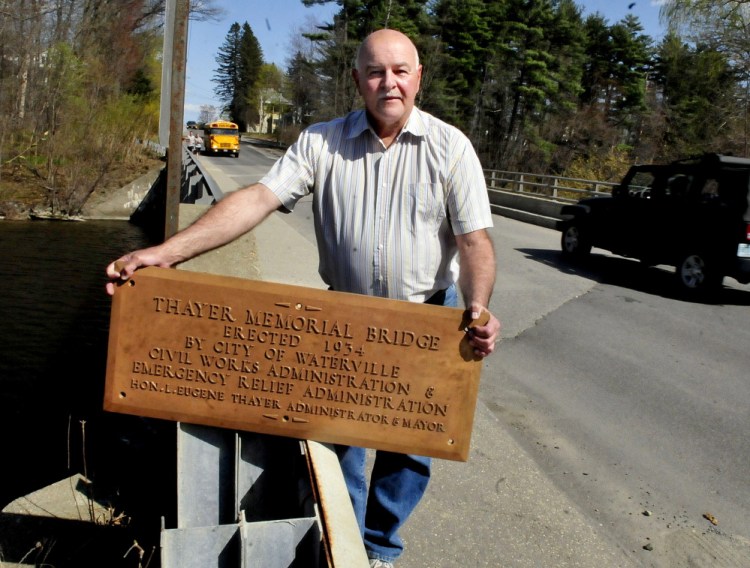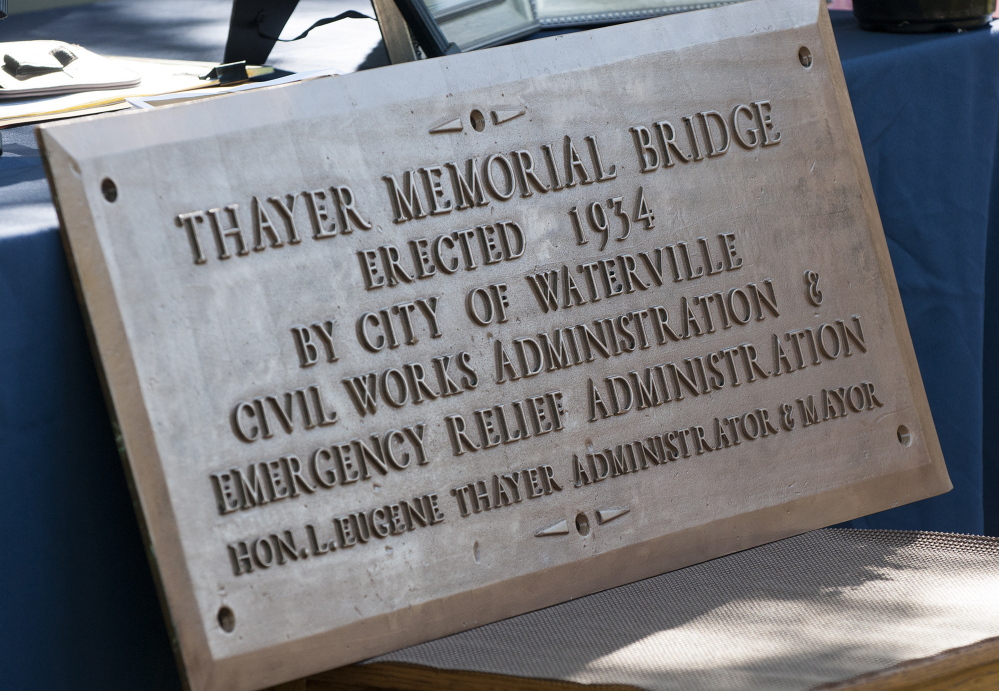Sometimes answers turn up at the most unexpected moments. Or, to put it another way, if we wait long enough, answers to mysteries will reveal themselves.
Such appears to be the case with the Thayer Memorial Bridge plaque I wrote about two years ago. A Benton contractor had found it in his garage under a 10-year-old pile of rubble and took it to the City of Waterville Public Works Department, realizing it probably had some historical significance.
At the time, Jim Goodwin, the contractor, said he thought his crew found it about 10 years prior while cleaning out the cellar of a home in the North End of Waterville. The woman who lived there had died and his company cleaned the house out for a real estate company. Goodwin’s crew dumped the plaque with other rubble in his garage and as time went by it got buried and he did not re-discover it until he cleaned the garage out two years ago.
Public Works Director Mark Turner did some digging of his own and learned the plaque had once graced the bridge on Gilman Street over Messalonskee Stream, but apparently it had been stolen many years ago.
The department restored the plaque and Turner hosted a re-dedication ceremony in September 2015 so it could be returned to the bridge, some 80 years after it was first erected there to honor Waterville Mayor Lorenzo Eugene Thayer. Thayer died in 1934 at age 51, the first city mayor to die in office. Thayer’s grandson, Whitcomb Rummel Jr., of Chapel Hill, North Carolina, attended.
A Waterville High School and Colby College graduate, Thayer also was one of the founders of the Waterville Morning Sentinel, which began publication in 1904 with Thayer as its treasurer. He was related to the Thayer family for which Thayer Hospital, now called the Thayer Center for Health, was named.
But back to the mystery part of the story.
When Goodwin brought the 2-by-3-foot, 50-pound bronze plaque to public works, Turner searched around the city and solved the mystery of where it had come from originally — the bridge — after he discovered an indentation in the bridge that the plaque fit into like a glove. Police Chief Joseph Massey talked with officers from the 1960s and ’70s, but none could recall the theft of the plaque. I checked Sentinel archives, but could not find anything about it either.
Fast forward two years — to about a week ago. I got an email from a former Waterville resident, Patrick Bureau, who lives in Portland but grew up on Pleasantdale Avenue in the city’s North End in the 1960s and ’70s. He said he just couldn’t keep what he knew to himself any longer. We spoke on the phone and he unraveled the plaque mystery a little more.
As a 12 or 13-year-old in the late 1970s, Bureau had a club house in the attic of his family’s garage that you could access by pushing up a trap door and climbing up a ladder into the A-shaped eaves. He and his buddies would hang old signs and posters on the walls and it was a cool place for them to hang out.
“One night, somebody came in — I could hear the garage door open,” Bureau recalled. “I remember opening the door to the club house and a neighbor friend was coming up the ladder. He was carrying the sign — the plaque that he had just pried off the bridge — to bring it up into the space, to say, ‘Look at this trophy I just got.'”
The signs the kids already had hung on the walls were only discarded signs and posters — none were taken off roads or stolen, according to Bureau. He said he was stunned to see the boy with the Thayer plaque, which he passed routinely on his way to school when he crossed the bridge.
“As he is halfway up the ladder, I was like, ‘Are you for real — are you kidding me? You’re not bringing it up here. I can’t even believe you did that — get that out of here right now. Bring it back. Put it back.’ I was beside myself. He told me he pried if off the bridge with a crow bar.”
The boy left with the plaque and Bureau said he has no idea what he did with it from there. And because so many years have passed since then, Bureau is a bit fuzzy as to exactly which neighborhood kid did it, though he can narrow it down to one of two boys, he says.
Bureau’s niece told him about the newspaper stories regarding the plaque and he decided he should call me and tell what he knows, he said.
“I was so young then and concerned that somehow I’d be implicated in it, I didn’t want to turn him in or get into trouble,” Bureau said. “My mom’s probably turning over in her grave — she would have been so upset if she knew because she knew the families that lived on our street. She would have been devastated.”
Bureau, who works for Fairpoint Communications, recalled that in the years after the plaque was stolen, he felt a twinge of guilt every time he drove across the bridge, knowing his neighbor had taken it.
“I could have made it right long ago,” he said. “When I read the stories about the plaque I was like, this is great but at the same time I had this feeling of dread and sadness that I had witnessed it. That I was somehow in the orbit of the person who did this is just bizarre.”
Bureau moved out of his house on Pleasantdale Avenue when he was 18 and later earned a Bachelor of Fine Arts degree from Portland School of Art. His mother sold the house on Pleasantdale and the garage remained there for many years afterward, but it was eventually torn down.
Bureau said one of the two boys who took the plaque now lives in New Hampshire and the other, possibly in southern Maine, though he has not been in touch with either.
“Obviously, the person that did it would know what happened,” Bureau said. “I just sort of tried to push it aside and forget it ever happened.”
I called Turner, the public works director, to let him know about Bureau’s recollections of the plaque. Turner said he does not blame Bureau for keeping mum for all these years.
“All 12-year-olds did some things that maybe they later felt a little guilty about,” Turner said.
He said Bureau’s story was interesting and shed a little more light on the mystery of the plaque.
“I’m glad that further damage didn’t occur to that plaque or the bridge and we were able to restore everything back to the original condition,” he said. “That story ended very nicely, considering.”
Amy Calder has been a Morning Sentinel reporter for 29 years. Her column appears here Mondays. She may be reached at acalder@centralmaine.com. For previous Reporting Aside columns, go to centralmaine.com.
Send questions/comments to the editors.





Success. Please wait for the page to reload. If the page does not reload within 5 seconds, please refresh the page.
Enter your email and password to access comments.
Hi, to comment on stories you must . This profile is in addition to your subscription and website login.
Already have a commenting profile? .
Invalid username/password.
Please check your email to confirm and complete your registration.
Only subscribers are eligible to post comments. Please subscribe or login first for digital access. Here’s why.
Use the form below to reset your password. When you've submitted your account email, we will send an email with a reset code.